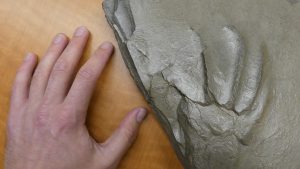This weekend is a chance to see fossil trackways, fossil invertebrates and fossil plants found in mines and other places from Alabama’s Coal Age up close and personal.

On Saturday, April 8, the Alabama Museum of Natural History and the Alabama Paleontological Society will host a free Fossil Track Meet from 11 am until 3:30 pm in the Grand Gallery of Smith Hall at The University of Alabama.
Dr. Adiel Klompmaker is the Curator of Paleontology at the University of Alabama Museums. He said visitors will learn what the Coal Age was like in Alabama millions of years ago.
“This is the natural heritage of Alabama. And over the last really 20 years, so much material has been found and has really become an important part of natural heritage of Alabama from back in those days,” he explained. “People get to see how Alabama looked like 315 million years ago… see firsthand fossils that will be on display on tables rather than behind glass. People get to see them up close, and you can see every detail.”